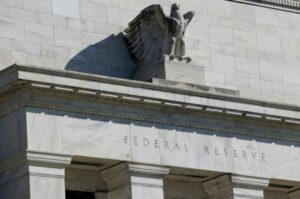




Philippines Trade Update: Exports momentum continues
 DOWNLOAD
DOWNLOAD

Quarterly Economic Growth Release: More BSP cuts to come
 DOWNLOAD
DOWNLOAD

Monthly Economic Update: Fed catches up
 DOWNLOAD
DOWNLOAD


As inflation cools, Fed seen cutting rates in May

COOLING INFLATION will allow the US Federal Reserve to forgo any more interest rate hikes and indeed to start cutting rates by May, traders bet on Tuesday, after a US government report showed consumer prices for October were unchanged compared with the prior month.
The report, which showed the consumer price index (CPI) rose just 3.2% from a year earlier, after rising 3.7% in September, “looked pretty good,” Chicago Federal Reserve Bank President Austan Goolsbee said at the Detroit Economic Club.
And while he said he wants to see further progress, particularly on housing inflation, the drop in CPI inflation from around 6.3% in January looks on track to be the fastest one-year peacetime decline in more than 40 years, he said.
Mr. Goolsbee didn’t update his view on the appropriate rate path on Tuesday, though even before Tuesday’s data he was not among Fed policy makers advocating for further policy tightening.
Prices of futures contracts that settle to the Fed’s target rate were pricing in only about a 5% chance the Fed will raise its policy rate any higher than the current 5.25% to 5.5% range, down from 28% prior to the Labor department report.
Core inflation, which excludes energy and food, rose 4% from a year earlier, the slowest pace in more than two years, the report showed. While still well above the Fed’s 2% target, the trend downward may give Fed policy makers more confidence that policy is tight enough to do the job.
“You can say goodbye to the rate hiking era,” said Brian Jacobsen, chief economist at Annex Wealth Management.
JPMorgan economist Michael Feroli, in a note to clients, said already low odds of a December rate hike have been further diminished by the CPI data, and he noted the numbers could also affect central bank forecasts due for release at the next Federal Open Market Committee (FOMC) meeting.
Mr. Feroli said with data pointing to fourth-quarter inflation moving under where the Fed thought it would be at the September FOMC and unemployment a touch higher, “it may be tough for them to justify offsetting a dovish hold with more hawkish dots.”
At the September Fed meeting Fed officials had penciled in one more increase in the federal funds rate, an increase they are now quite unlikely to deliver.
Meanwhile, the Fed is now seen as more likely than not to deliver its first rate cut in May, and end 2024 with the short-term benchmark rate a full percentage point lower than today, based on rate futures pricing.
The Fed last raised rates in July, but Fed Chair Jerome H. Powell as recently as last week said he would not hesitate to raise rates further should it be needed to beat inflation back.
Tuesday’s data lessens the pressure for further tightening, but US central bankers aren’t likely to take a victory lap yet, according to Nationwide Chief Economist Kathy Bostjancic.
“The Fed for now will maintain its tightening bias, erring on the side of caution,” she wrote. — Reuters
This article originally appeared on bworldonline.com





 By BusinessWorld
By BusinessWorld